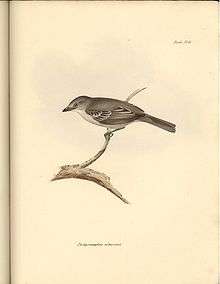Suiriri flycatcher
| Suiriri flycatcher | |
|---|---|
 | |
| Suiriri flycatcher at Boa Esperança do Sul, São Paulo State, Brazil | |
| Scientific classification | |
| Kingdom: | Animalia |
| Phylum: | Chordata |
| Class: | Aves |
| Order: | Passeriformes |
| Family: | Tyrannidae |
| Genus: | Suiriri |
| Species: | S. suiriri |
| Binomial name | |
| Suiriri suiriri (Vieillot, 1818) | |
The suiriri flycatcher (Suiriri suiriri) is a species of bird in the family Tyrannidae found in semi-open habitats in South America. It was formerly split into two species; the Chaco suiriri (S. suiriri) and the Campo suiriri (S. affinis). Suiriri originates from Guaraní, where it is a generic name used for several medium-sized tyrant flycatchers.[2]

Taxonomy
The suiriri flycatcher has traditionally been split into two species, the southern Chaco suiriri (S. suiriri) with a white belly and the northern Campo suiriri (S. affinis) with a yellow belly and a contrastingly pale rump, but they interbreed widely where they come into contact, and consequently most authorities now consider them to be part of a single species. It has been suggested that the taxon bahiae from north-eastern Brazil, which is considered a subspecies of S. affinis when that species is split from S. suiriri, actually is the result of hybridization between suiriri and affinis. For the most part it resembles the latter, but it lacks a contrastingly pale rump as the former.
The chapada flycatcher is a cryptic species that was included within the suiriri flycatcher until it was described in 2001. While both these species are relatively noisy, only the chapada flycatcher has the distinctive wing-lifting display.
Distribution and habitat
The suiriri flycatcher occurs in a wide range of semi-open habitats such as Chaco, Caatinga and Cerrado, but generally avoids humid habitats such as the Amazon Rainforest. It ranges from northern Argentina, through Uruguay, Paraguay, eastern Bolivia, to a large part of eastern Brazil, with disjunct populations in southern Guyana, Amapá, and near the lower section of the Amazon River and central Madeira River. These disjunct populations are associated with remnant patches of relatively dry woodland and savanna that largely – or entirely – are surrounded by humid Amazonian forests.
It is fairly common locally, and consequently considered to be of least concern by BirdLife International.
References
- ↑ BirdLife International (2012). "Suiriri suiriri". IUCN Red List of Threatened Species. Version 2013.2. International Union for Conservation of Nature. Retrieved 26 November 2013.
- ↑ "Suiriri Flycatcher". Faunaparaguay.com. Retrieved 2 February 2009. External link in
|website=(help)
External links
| Wikimedia Commons has media related to Suiriri suiriri. |
| Wikispecies has information related to: Suiriri suiriri |
- BirdLife species factsheet for Suiriri suiriri
- "Suiriri flycatcher media". Internet Bird Collection.
- Suiriri flycatcher photo gallery at VIREO (Drexel University)
- Suiriri flycatcher species account at NeotropicalBirds (Cornell University)
- "Suiriri [suiriri or affinis]". Avibase.

- Interactive range map of Suiriri suiriri at IUCN Red List maps
- Audio recordings of Suiriri flycatcher on Xeno-canto.
